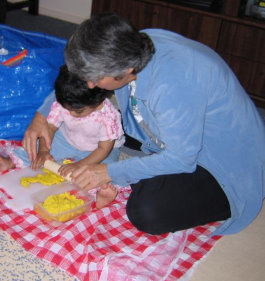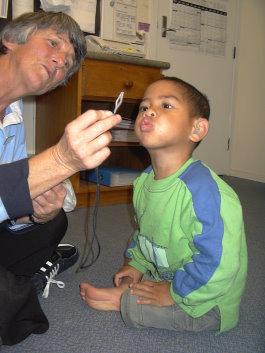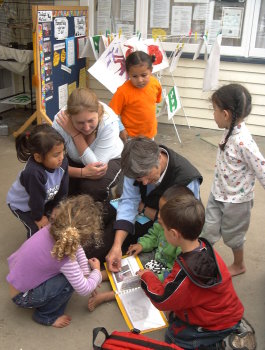Theosophy in the workplace:
A teacher’s perspective.
An interview with Susan SkarsholtIf someone were to ask you how you apply Theosophy in your job, would you be stuck for an answer? Perhaps there is no direct application of its principles in your field. Yet, somehow, there is a level at which Theosophy has an influence on all you do, isn’t there? In this interview we ask Susan Skarsholt, a New Zealander who specialises in teaching deaf children aged three to six.
Q: How has Theosophy helped you in dealing with the deaf? Many Theosophists are at a loss as to how to introduce theosophical concepts to their own young children, let alone to hearing-impaired ones in a formal educational setting.
Susan: If by ‘introducing theosophical concepts’ you mean building ideas like spiritual evolution, karma and reincarnation explicitly into lesson plans, I’m afraid I simply cannot do it, though I have done it for years at the TS in Auckland with the children who participate in the ceremonial work of the Order of The Round Table. In working with deaf pre-school children, the principal challenge is in fact that of developing my own capacity to meet the difficult situations I’m faced with! I have to spend a lot of time dealing with angry, grieving or troubled parents and this requires drawing upon inner resources.
When a parent discovers their child is deaf, their reaction is similar to what it would be if the child had died. In a sense, their perfect child has died, and they now have this ‘defective’ substitute. They tend to go through the same process as the parents of dead children – denial, anger, grieving, and (if we are lucky) acceptance and constructive work with the child. Unfortunately, this sequence can take many years to cover. Some never get past the first three phases and a few get stuck on the first one – denial – for the whole of the child’s life. As I deal with children who are newly diagnosed, their parents are usually in the throes of the first two phases. Their minds and emotions have gone into overload and they sometimes need to be given important information two, three or many more times before they register it.
So as I say, the application of theosophical teachings is mostly on myself, trying to develop the necessary patience, understanding and wisdom with parents in distress. I need to give them practical ideas and assistance, to help them through this initial confusing maze. Once they are through the first stages of the process, then perhaps theosophical ideas could be introduced to help them come to terms with the challenge before them, but they are simply too overwhelmed to hear or absorb anything at first. They are in survival mode – or total rejection.
Q: Karmically speaking, how do you explain the tragedy of a handicap such as deafness? Do you think that the spiritual self is learning much through a limited body?
Susan: I can’t speak with authority on karmic causes. One explanation might be that deafness in this life is related to the closing off of the mind in a previous one, to a refusal to acknowledge or listen to others, but we have to be careful of simplistic explanations. Whatever the case, I would imagine the incarnation to be one of frustration for the inner self, as outer limitations make inner progress so very difficult. Being deaf results in a tragic restriction of information and understanding about people and the world around. Concepts are frequently very limited, and understanding is related to things physical. The subtleties of language are of course not known or understood at first, and deaf children’s world is a small one of things they have experienced. They are unable to relate their experiences to the wider world, because they are unaware that the same things happen to others. As a result, they are egocentric, functioning on a basic, material level.
Many years ago now, I taught autistic twins. As part of my attempt to reach through the ‘barriers’ blocking out the world around, I asked Geoffrey Hodson, who was living in Auckland at the time, if he would be so kind as to look at them clairvoyantly.
After gaining permission from the people involved, including the boys’ parents, Geoffrey visited the kindergarten the boys attended, and sat quietly observing them for some time. Autistic children are not very aware of others as a rule, but on this occasion, one of the twins certainly gave Geoffrey several sideways looks. His presence was powerful enough to attract attention without words.
Later, Geoffrey said that the ego or higher self appeared to be blocked from connecting with the lower vehicles of the personality (partially or fully blocked? – I can’t remember). I feel the same blockage occurs with a large number of the deaf people I know. Overcoming this tremendous barrier takes a superhuman effort from the deaf individuals concerned, and there is usually still a slight limitation, even in the most orally proficient deaf person. It’s really very hard to say what the learning is at the inner level, though it is clear to me that the more restricted the outer vehicle, the harder the soul’s task is.
Sometimes I feel the deaf individuals are almost secondary in the puzzle, as they are often unaware of the extent of their limitations. The parents and families suffer terribly through the lack of communication, however. While it is very sad that the deaf individuals may never reach their full potential as human beings in this incarnation, it is often their families who suffer and grow the most. In this sense, it seems more instructive to examine the operations of karma from the angle of effects rather than that of causes. In other words, while I wouldn’t say that a child is born deaf in order to teach those around them soul lessons, the effect is often one of growth for them. Family members need to develop tolerance, patience, acceptance, understanding... in short, inner strength. What excellent training for treading the spiritual path!



